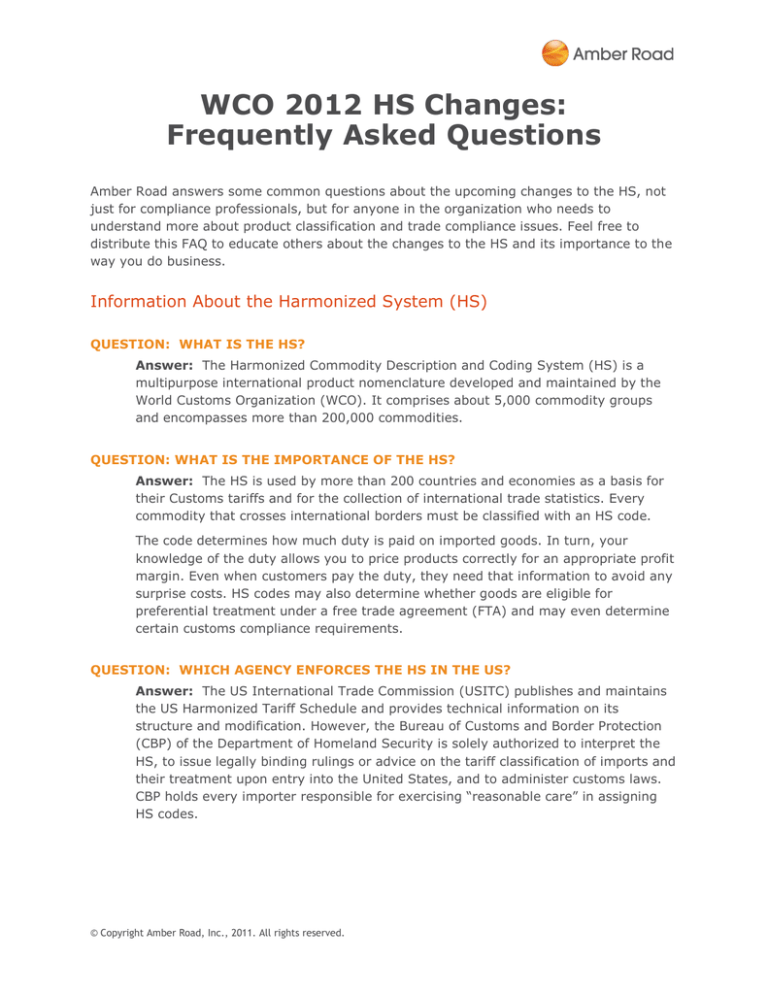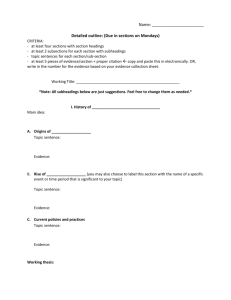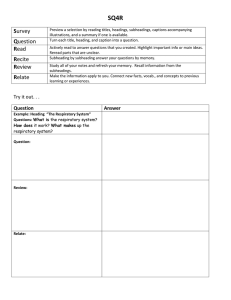
WCO 2012 HS Changes:
Frequently Asked Questions
Amber Road answers some common questions about the upcoming changes to the HS, not
just for compliance professionals, but for anyone in the organization who needs to
understand more about product classification and trade compliance issues. Feel free to
distribute this FAQ to educate others about the changes to the HS and its importance to the
way you do business.
Information About the Harmonized System (HS)
QUESTION: WHAT IS THE HS?
Answer: The Harmonized Commodity Description and Coding System (HS) is a
multipurpose international product nomenclature developed and maintained by the
World Customs Organization (WCO). It comprises about 5,000 commodity groups
and encompasses more than 200,000 commodities.
QUESTION: WHAT IS THE IMPORTANCE OF THE HS?
Answer: The HS is used by more than 200 countries and economies as a basis for
their Customs tariffs and for the collection of international trade statistics. Every
commodity that crosses international borders must be classified with an HS code.
The code determines how much duty is paid on imported goods. In turn, your
knowledge of the duty allows you to price products correctly for an appropriate profit
margin. Even when customers pay the duty, they need that information to avoid any
surprise costs. HS codes may also determine whether goods are eligible for
preferential treatment under a free trade agreement (FTA) and may even determine
certain customs compliance requirements.
QUESTION: WHICH AGENCY ENFORCES THE HS IN THE US?
Answer: The US International Trade Commission (USITC) publishes and maintains
the US Harmonized Tariff Schedule and provides technical information on its
structure and modification. However, the Bureau of Customs and Border Protection
(CBP) of the Department of Homeland Security is solely authorized to interpret the
HS, to issue legally binding rulings or advice on the tariff classification of imports and
their treatment upon entry into the United States, and to administer customs laws.
CBP holds every importer responsible for exercising “reasonable care” in assigning
HS codes.
© Copyright Amber Road, Inc., 2011. All rights reserved.
WCO 2012 HS Changes: FAQ
QUESTION: HOW IS THE HS MAINTAINED AND UPDATED?
Answer: The Harmonized System is governed by The International Convention on
the Harmonized Commodity Description and Coding System. Updates are
administered by the WCO and occur every five years. They are based on input from
member countries and changes in trade practices. Each proposed change goes
through a review and comment process. The last review was in 2007 and the
upcoming 2012 changes will be effective as of January 1, 2012.
QUESTION: HOW IS THE HS STRUCTURED?
Answer: The HS provides a logical structure which consists of 97 Chapters (some
countries also have chapters 98 and 99), arranged in 21 Sections. Each chapter is
identified by a four-digit heading, which in turn contains 6-digit subheadings. The
first two digits of an HS code indicate the Chapter, and the next two digits indicate
the order of the heading in the Chapter. Thus, heading 10.01 is the first heading of
Chapter 10. In addition, most of the headings are subdivided into 1-dash
subheadings. Where necessary, the subheadings are further subdivided into 2-dash
subheadings identified by a 6-digit code (HS code).
The HS comprises over 5,000 separate groups of goods identified by a 6-digit code.
The first four digits correspond to the relevant heading number, while the fifth and
sixth digits identify the one- and two-dash subheadings respectively. The absence of
subheadings is indicated by a zero.
For example:
•
•
•
HS code 0803.00 means the third heading of Chapter 8, which has not been
subdivided
HS code 0101.10 means the first heading of Chapter 1, first subheading
which has not been further subdivided
HS code 0303.11 means the third heading of Chapter 3, first two-dash
subheading of the first one-dash subheading.
QUESTION: WHAT ARE THE “EXPLANATORY NOTES?”
Answer: The official interpretation of the HS is given in the Explanatory Notes (5
volumes in English and French) published by the WCO. The text consists of
explanations of the General Rules of Interpretation, Section Notes, and Chapters and
Subheadings. It also provides detailed explanations on the scope of headings and
subheadings, together with technical descriptions of the goods concerned and
practical guidance for their classification and identification.
QUESTION: WHEN WILL THE NEW EXPLANATORY NOTES BE AVAILABLE FOR
PURCHASE?
Answer: The Notes can be ordered now from the WCO bookstore.
2
WCO 2012 HS Changes: FAQ
QUESTION: WHAT IS “SCHEDULE B?”
Answer: Schedule B refers to the HS-based numbering scheme used by the US to
track exported goods. In fact, a product's Schedule B number is nothing more than
its six-digit HS number with four additional digits on the end.
QUESTION: WHICH AGENCY MAINTAINS SCHEDULE B?
Answer: The US Census Bureau administers the Schedule B system. Schedule B
numbers, not HS numbers, must be used in the Automated Export System (AES).
The Census Bureau uses the AES filings and Schedule B numbers to calculate US
export statistics. The Census Bureau sponsors a free online reference tool called the
Schedule B Search Engine that can be used to classify products.
QUESTION: WHAT IS AN EXPORT CONTROL CLASSIFICATION NUMBER?
Answer: An Export Control Classification Number (ECCN or sometimes just ECN) is
an alpha-numeric classification used to identify items for export control purposes. An
ECCN has five characters and corresponds to the 10 categories in the Commerce
Control List. The proper classification of an item is essential to determining any
licensing requirements under the Export Administration Regulations (EAR). The
Department of Commerce is responsible for enforcement of the EAR.
QUESTION: SO, WHAT IS THE DIFFERENCE BETWEEN THE HS, SCHEDULE B AND
ECCN?
Answer: The HS, maintained by the USITC and enforced by CBP is for goods
imported to the US. It is an international standard that the US supports. Schedule B,
maintained by the Census Bureau, is for use in the AES to track goods exported from
the US. The ECCN, also used when filing in the AES, is maintained by the
Department of Commerce to determine whether certain goods require export
licenses. Both Schedule B and the ECCN are specific to the US. Other countries have
different export regulations and systems.
About the 2012 Changes
QUESTION: WHAT IS THE FOCUS OF THE 2012 CHANGES?
Answer: In general, the focus of the 2012 changes is to:
•
•
•
•
Increase the precision of the nomenclature texts to ensure their uniform
application
Take account of environmental and food security concerns
Tailor the nomenclature to reflect current trade practices
Reflect advances in technology that occurred since the last HS amendment
3
WCO 2012 HS Changes: FAQ
For example, changes in international trade patterns have resulted in the deletion of
subheadings due to the low volume of trade in these particular products.
QUESTION: WHAT IS THE EXTENT OF THE 2012 CHANGES?
Answer: The changes are as follows:
•
•
•
•
54 – Number of Chapters affected
95 – Number of Subheadings removed
421 – Number of Subheadings added
34 – Number of Subheadings changed
Additionally, the changes break out by sector, as follows:
•
•
•
•
•
•
•
98 relate to the agricultural sector
27 to the chemical sector
9 to the paper sector
14 to the textile sector
5 to the base metal sector
30 to the machinery and hi-tech sector
An additional 37 that apply to a variety of other sectors
QUESTION: ARE THE WCO PARTICIPATING COUNTRIES GOING TO UPDATE THE HS
INDEPENDENTLY AND WHEN WILL THAT HAPPEN?
Answer: Each country that is a contracting party of the WCO must go through its
own legislative or regulatory process to implement HS 2012. The timing will be
determined by the process in the individual countries.
QUESTION: WILL SCHEDULE B CHANGES BE IMPLEMENTED AT THE SAME TIME AS
THE HS CHANGES?
Answer: Most likely yes, the AES Schedule B will be updated with the WCO 2012
changes.
QUESTION: DO YOU KNOW WHEN THE US WILL PUBLISH THE NEW TARIFF?
Answer: We expect to see the first of the US updates in November, 2011.
QUESTION: WILL THERE BE A TRANSITION PHASE OR GRACE PERIOD?
Answer: Not at this point. We expect the US changes to be published in November;
thus giving all parties enough time to conduct the necessary reclassifications before
the first of the year.
4
WCO 2012 HS Changes: FAQ
QUESTION: WHAT IS THE EARLIEST THAT WE WILL BE ABLE TO SEE THE CHANGES
FOR CANADA AND MEXICO?
Answer: Canada typically publishes its tariff several weeks before the
implementation date. Typically, that is at the end of November or beginning of
December. Mexico, on the other hand, publishes its new tariff on or close to the
implementation date, typically at the beginning of January.
QUESTION: WHAT ABOUT COUNTRIES THAT ARE MEMBERS OF THE EU?
Answer: Typically, the EU Commission publishes a partial tariff (containing the first
8 digits) at the end of October. This tariff will be published in the official journal,
which is accessible online. The EU Commission also publishes correlation tables,
typically in December.
The HS Changes and You
QUESTION: HOW WILL I KNOW WHAT HAS CHANGED?
Answer: Amber Road will provide a “Change Report” to its customers for the US
updates, showing both new and expired HS numbers. You can also see the changes
here.
We will also be sending out a change report to our customers on a per country basis
as the tariffs are published by their respective governments.
QUESTION: HOW WILL THE CHANGES POTENTIALLY AFFECT MY ORGANIZATION?
Answer: Depending on the types of products you export and import, you may need
to change their classifications. Reclassification could potentially affect any associated
licenses, authorizations and inspections. It may also affect how those products are
treated under any preferential trade agreements, since reclassification may involve
rules of origin.
QUESTION: WHAT CAN I DO TO GET READY FOR THE CHANGES?
Answer: To determine the scope of impact on your organization, you must
understand the extent to which your products are classified. Up to 100 classified
products may be easy to research and change manually, but if you have thousands
of products that need to be reclassified, you may need the assistance of a tool that
will enhance and expedite the classification process.
QUESTION: WHAT TOOLS ARE AVAILABLE TO HELP ME WITH CLASSIFICATION?
Answer: As demonstrated in our recent webinar, Amber Road provides an
application called Trade Wizards to assist with product classification. Trade Wizards is
an online application that allows you to easily perform product classification, landed
cost calculation and restricted party screening, among other transactions. These
5
WCO 2012 HS Changes: FAQ
important processes can ensure that you understand the associated costs and
regulations around transporting your goods.
QUESTION: I MISSED THE RECENT WEBINARS – WHERE CAN I WATCH THE
RECORDINGS?
Answer: You can register to watch these webinars on demand at any time.
•
•
“WCO 2012 HS Changes: Is Your Company Prepared?” and
“Trade Wizards: Your Solution to the WCO HS Changes (and More!)”
About Amber Road, Inc.
Amber Road provides a single, on-demand platform that automates and streamlines global
trade. By helping organizations to comply with country-specific trade regulations, as well as
plan, execute and track global shipments, Amber Road enables goods to flow unimpeded
across international borders in the most efficient, compliant and profitable way. For more
information, please visit www.AmberRoad.com or call (201) 935-8588.
6



